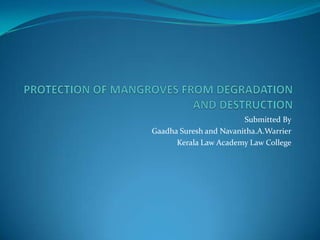
Power point presentation on protection of mangroves from destruction and degradation
- 1. Submitted By Gaadha Suresh and Navanitha.A.Warrier Kerala Law Academy Law College
- 2. OUTLINE Mangrove Defined Occurrence Importance of mangroves Threats to Mangroves Causes for destruction and degradation of Mangroves Steps taken towards conservation Suggestions
- 3. Mangroves- Defined A mangrove is a tree, shrub, palm or ground fern, generally exceeding one half meter in height It normally grows above mean sea level in the inter-tidal zone of marine coastal environments and estuarine margins. Mangroves dominate three-quarters of tropical coastlines. Mangrove swamps are found in tropical and subtropical tidal areas.
- 4. OCCURANCE Mangroves can be found in over 118 countries and territories in the tropical and subtropical regions of the world. Approximately 75% of the world’s mangroves are found scattered in about15 countries. Asia has the largest amount (42%) of the world’s mangroves, followed by Africa (21%), North/Central America (15%), Oceania (12%) and South America (11%).
- 5. The richest mangrove communities occur in tropical and sub-tropical areas with temperature greater than 24 degree In India, the total area of Mangroves is about 6,740 sq. km, {7% of the world total area of mangroves}. Around 20% of the mangroves in India are on the west coast i.e from Kutch to Kerala.
- 6. IMPORTANCE OF MANGROVES Acts as Buffer Zone between the land and sea. Protects the land from erosion. Plays a significant role as nature's shield against cyclones, ecological disasters and as protector of shorelines. Acts as Breeding and nursery grounds for a variety of marine animals. Harbours a variety of life forms like invertebrates, fish, amphibians, reptiles, birds and even mammals like tigers.
- 7. Good source of timber, fuel and fodder. Main source of income generation for shoreline communities like fisher folk. Saves the fast diminishing marine diversity, Purifies the water and air by absorbing pollutants and impurities Potential source for recreation and tourism.
- 8. THREATS TO MANGROVES Mangrove forests are fading into disappearance all over the world. They were estimated to cover 18.1 million sq. km worldwide but a more recent study estimates it around 15 million sq. km. The world mangrove experts opine that the mangroves may be totally lost within 100 years. In the sheltered tropical coastlines such as delta areas of Ganges-Brahmaputra, Irrawaddy and Niger as well in the coastlines of the Malacca Straits, Borneo and Madagascar, mangrove areas are under heavy human pressure.
- 9. Country Period of Record Estimated original Estimated present Percentage (%) mangrove area (ha) mangrove area (ha) Cuba 1969-1989 476000 448000 94 Bangladesh 1963-1990 685000 587000 86 Guatemala 1965-1978 58000 50000 86 Peninsular Malaysia 1979-1986 113000 89000 79 Ecuador 1966-1989 235000 177500 76 Thailand 1961-1993 300000 219200 73 Vietnam 1969-1990 425000 286400 67 U.S.A 1958-1983 260000 175000 67 Colombia 1976-1989 480000 307000 64 Indonesia 1969-1986 4220000 2176000 52 Philippines 1968-1995 448000 140000 31 Singapore 1922-1989 700 180 26 Puerto Rico 1930-1985 26300 3000 11 India 1911-1989 70000 250 4
- 10. CAUSES OF DEGRADATION AND DESTRUCTION OF MANGROVES Aquaculture Practices Urbanization Cutting for timber,fuel and charcoal Agriculture Mining Operations War Problems Prevention of fresh water flow and tidal flow Oil Pollution Pollution Issues
- 11. CAUSES OF DEGRADATION AND DESTRUCTION OF MANGROVES Aquaculture Practices Urbanization Cutting for timber,fuel and charcoal Agriculture Mining Operations War Problems Prevention of fresh water flow and tidal flow Oil Pollution Pollution Issues
- 12. STEPS TAKEN TOWARDS CONSERVATION Grassroots efforts to save mangroves from destruction are becoming more popular In some areas, mangrove reforestation and mangrove restoration is underway. UNDP/UNESCO has played a key role in bringing out awareness on the mangrove destruction and on why it needs to be conserved.
- 13. The National Mangrove Committee at the Ministry of Environment and Forests was set up by the Government of India in 1976, for advising the government on mangrove conservation and development. Activities sponsored by the UNDP/UNESCO -Regional mangrove project have greatly contributed to mangrove awareness in India.
- 14. HOPE (Here On Project Environment), -NGO from Mumbai has undertaken a program of mangrove plantation - Rutuchakra, Maharashtra, India. Horticulture department has undertaken integrated Rehabilitation and Conservation effort through massive “Afforestation program” since 2005 in Thane Municipal Corporation.
- 15. SUGGESTIONS Practical means of protection of mangroves should be evolved Urgent new laws and regulations should be framed for the protection of mangroves. Human encroachment in mangrove forests should be discouraged. Importance of protection of mangroves should be brought to the limelight. Mining operations near mangroves should be legally stopped
- 16. In order to determine the most effective remedial measures, individual study has to be conducted. Continued monitoring and assessment should be conducted
